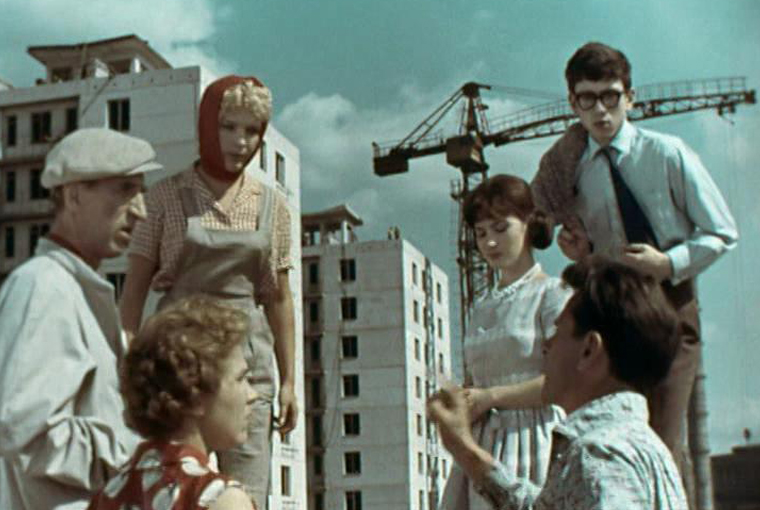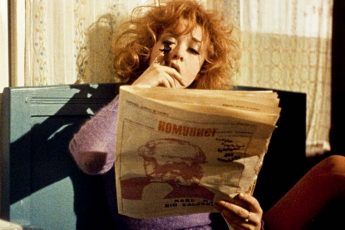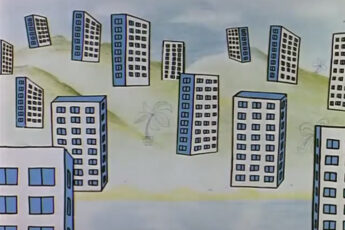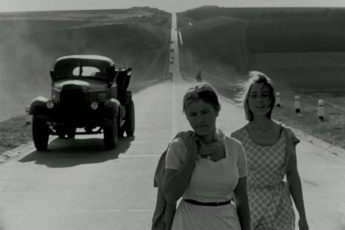Urban Planning as a Shifting Symbol in Soviet and post-Soviet cinema
Vol. 113 (March 2021) by Anna Guboglo
The landscape is a strikingly active element in Soviet cinema, be it in its urban, industrial, natural, or fantastic forms. In the state-censored and moralistic cinema of the Soviet Union, characters interact with landscapes in such a manner that the latter are also transformed into characters. This attention to surroundings is unsurprising, since at the foundation of historical materialism lies the formula that „the social being determines the consciousness”.1 First introduced in the cinematographic urban landscape in the early 1960s, entire districts built with three- to five-storied concrete panel buildings (khrushchyovky) were a symbol of progress and of the beginning of a new era for the Soviet people. They represented a solution to the housing shortage, improving the living conditions for millions of people all over the Soviet Union and in the countries of the Eastern Bloc. However, if these districts and the buildings themselves are to be understood as characters, or more precisely as symbols, their value degrades concomitantly with the weakening of state censorship since 1986.
This article will analyze the attitude toward the new-type buildings in a row of 1960s films, as well as the formal means of its emphasis. In a second step, the meanings invested into the display of the khrushchyovka districts throughout the late 1980s, culminating with post-Soviet cinema, are brought into discussion. The differences in the apprehension of the material and symbolic meaning of these buildings open the third level of analysis. As the new, uncensored cinema presents projects deeply rooted in individual imagination as opposed to overedited oeuvres, the theme of protest runs like a red thread through the 1980s-1990s cinema. Closely following the social impact of the films’ representations, this essay will reflect on the problematic of the relation between cinema, societal expectations, and urban realities.
It is unsurprising that aspects of the reconstruction of Soviet cities after the Second World War should represent a consistent part of filmmakers’ agendas. In the Cold War paradigm, urban reconstruction was part of the race to demonstrate the efficacy of the regime to its own citizens and to the West. The discourse centered on overcoming the West in terms of people’s living conditions persisted since the speeches of Politburo members in the 1920s, and was perpetuated by Nikita Khrushchev with his infamous bravado during his visit to the United States.
Before the Second World War, new-type apartment buildings had not been a prevalent theme. Movies were most interested in displaying the work routines at industrial plants and factories as well as the construction of railroads, transmission towers or bridges in places as remote as the Siberian wilderness. The 1938 film The New Moscow (Novaya Moskva directed by Aleksandr Medvedkin and Aleksandr Olenin) stands apart with its focus on the dynamics of the en masse transformation of the pre-Soviet architectural landscape. Its plot was concerned exclusively with the change in the architectural outlook of the capital. It revolves around the adventures of a young muscovite engineer who, having worked in the Taiga wilderness, returns to Moscow with a live model of a “New Moscow”. The film, which was shot just three years after the general plan of the reconstruction of Moscow was adopted, contains significant and highly emphatic scenes that reflect Mosfilm’s interpretation of the urban planning policy. The speed of the changes illustrated in the movie is such that in one of the opening scenes, a painter trying to sketch the “Old Moscow” has to stop halfway because the buildings are disappearing right in front of his eyes. This film, as well as other movies of the Stalinist era touching on the (re)construction of the Soviet economy, were concerned with great architectural projects rather than with apartment buildings.
It was only in the cinema of the 1960s that the new apartment blocks became part of the landscape, gaining a central role in numerous films. Herbert Rappaport’s 1962 popular musical Cherry Town (Cheremushky) was one of the first films to mark the establishment of this new theme in the film industry. Juxtaposition was a beloved instrument of emphasis in the naïve Soviet films of the 1960s. Along these lines, the superior quality of the new block buildings was portrayed through obvious contrast with architectural remnants of the old regime. Cherry Town opens by displaying a life-threatening crumbling of an old shack, which used to be home to a family of two. The conflict, then, revolves around the quick accommodation in a private apartment in a newly built building. The family’s accommodation is unmistakably connected to the functionality of the whole state system, and character types such as the government official, working class citizens, and privileged but unscrupulous tenants-to-be illustrate the existing social order and the eventual triumph of justice.
Similarly, in Felix Mironer’s The Street of Youth (Ulitsa molodosti, 1958), the emphatic repertoire operates on the contrast between old and new. The opening scenes show a forceful demolition of an old and damaged building that is to be replaced with long-awaited apartment buildings. The film, however, delves more explicitly into the topic of age, creating a tangible link between youth and access to rather modern living conditions. In fact, it is typical of Soviet films of the time to associate construction sites of any type with young people (volunteers or young foremen), presenting the former as places of social bonding and personal formation for the latter.
In the same way, Villen Azarov’s 1961 Adult Children (Vzroslye deti) insinuates that the opportunity provided by modern housing constitutes a new beginning not only for young people, but for entire generations of new families who will finally be able to afford to settle in a more “progressive” environment. Unlike other films, Adult Children explicitly ties the idea of new-type buildings in with chances for better lives for young families by emphasizing the necessity of the new generation to live separately and break with the lifestyle choices of their parents or grandparents. It does so through the unfolding of the plot rather than by using suggestive imagery, as was done in The Street of Youth. While both movies belong to the same thematic paradigm, they presumably targeted different audiences, which would explain their stylistic differences. The Street of Youth is reminiscent of Stalinist cinema in its declamatory statements and idealistic speeches. Meanwhile, Adult Children is a story of a metropolitan couple of architects struggling to balance their private space with the one shared with their parents. Comic elements contribute to thinning down the protagonists’ idealism, especially since the visual row is dedicated almost entirely to family life within their uncomfortable apartment. The fact that the main characters are architects, allows for a brief introduction of some theoretical aspects of the planning of new-type apartments. However, they are useful mainly because it sets up the generational conflict due to the older and conservative family members’ lack of understanding.
In all these cases the processes of building, moving and completing the last furnishings are concomitant with the accomplishment of the protagonists’ storylines, namely their falling in love and starting families. In this way, rather than depicting the new apartment buildings for what they were, their representation was integrated into the main characters’ storylines, while direct information on the advantages of this form of housing was casually transmitted through other characters. The visual representation of the apartments and built-in districts prioritized their depiction as central, light, and spacious places, the movies’ musicality further aiding the atmosphere.
Almost immediately after 1965, the thematic novelty of these buildings was lost due to the slowing construction rate. Movies like Naum Birman’s Step Forward (Shag navstrechu, 1975) reveal that even when the apartments, block houses and districts have a crucial function in the unfolding of the plot, the films cease to reflect on the nature and significance of the new form of urban planning. The block house districts in the opening of the film are the place where the characters’ journey starts, but the buildings are not really associated with any meaningful events in their lives, rather representing a starting point in their daily displacement from the periphery to the center. The crowdedness and dynamic rhythm of the area indicates the fragmentation of the collective, the foreignness and loneliness of each single person.
There was a key factor responsible both for the popular success of the block houses in the 1960s and for their massive unpopularity at the time of the dissolution of the Soviet Union that is well-represented in the cinemas of the respective time periods. It concerns the uniformity of the living conditions of citizens of all social backgrounds and all over the Soviet Union. Many Soviet situational comedies played on different people’s apartments being close to identical. Thus, in a final scene from Cherry Town (Cheremushky), dozens of neighbors come uninvited to the protagonists’ apartment in order to take a look at their apartment, knowing that the apartments provided to them will be exactly the same. In 1962 the spirit of commonality was indeed still portrayed as natural and amusing. Even in 1976, the whole conflict of Eldar Ryazanov’s famous Irony of Fate, or Enjoy Your Bath! (Ironiya sud’by, ili S lyogkim parom!) was built upon the main character’s unintentional trespassing of another apartment in a different town, the confusion stemming from the (somewhat exaggerated) fact of the street name, the apartment block building, the apartment set-up, and even the key lock being identical across Moscow and Leningrad.
This very similitude became the focal point of discontent towards the end of Brezhnev’s stagnation era. Just as apartments were starting to become an integral part of urban life, commodities were becoming more and more unavailable to the general public. The Soviet nation lived through a prolonged period of disenchantment with the early-Soviet egalitarian principles, culminating with the post-Soviet era of denial. Uniformity stopped being synonymous with prosperity and turned into a metaphor of universal poverty. So at a time when cities became places of poverty and crisis, a clear instigating factor was provided by the unchanging and monolithic urban outlook.
In Nikita Mikhalkov’s Family Relations (Rodnya, 1981) the imagery of panel housing districts is used to emphasize the solitude of urban dwellers, and the discouraging similitude of the fates of numerous families living in the apartments. The modern apartment, as all other attributes of Soviet modernity, deepened a sense of derailment of family relations, and provided the scenery for ongoing family drama. Soviet dramas of this decade typically chose the apartment’s four walls as both the locus and the reason for personal conflicts.
The aesthetics of the 1990s films, in their turn, were a product of the gradual cancellation of censorship in all cultural spheres beginning with 1986, when Mikhail Gorbachev announced the policy of Glasnost’. At the same time, after 1988 the first state-approved cooperative and private film studios saw the light of day. The sudden and sensitive shift in visual culture and artistic discourses occurred during the late phase of the dissolution of the Soviet Union, without doubt owing to the general atmosphere of decadence and disappointment. As already noted, the panel houses remained a symbol of Soviet central planning; only now, all attributes of the ancien régime were deprived of their authority.
The symbolic significance of the panel houses turned from modern to obsolete, and from progressive to naïve. They came to be the visual representation of the worst social issues, as the most visible and unanimously present urban element, with the word “khrushchyovka” actually entering the cinematographic lexicon. In Dmitry Astrakhan’s You Are My Only Love (Ty u menya odna, 1993), the main character’s young daughter cries out to him, “Do you want me to live in this kennel for the rest of my life?”. The “kennel” she refers to is their Moscow apartment building and is here being used as an argument to explain her dream of moving to the United States for a better life. The image of their middle-class apartment and panel house, along with the representation of the city transportation (once also subject to cinematographic eulogies), creates the emotional coloring of the film, shaping the sensation of desperation half-expressed through dialogues. The now-classical Brother (Brat, by Alexey Balabanov), released in 1997, gained its reputation for being a “flagship” or emblem of the 1990s era. This is owed less to its action scenes, and more to what is perceived as an accurate depiction of the social turmoil and of the urban reality at the time. The latter is represented through Saint Petersburg’s courtyards, flights of stairs within block buildings and apartment interiors, all explicitly showing signs of ruination.
As a response to the expectations of certain parts of the audience, the 1990s film aesthetics leaned toward “difficult” movies as opposed to entertainment, specifically to the genre of social drama. 1990s cinema was marked by a predilection for naturalism and shocking visual sequences. Due to the prolific practice of viewers sending feedback to film studios and newspapers, it is possible to assess people’s opinions on specific movies and on the change of course the Soviet film industry had generally taken. In the early 1990s only a small part of the audience was thrilled with the “lifelikeness” of newer films, while the vast majority expressed a sense of nostalgia for older cinema, referring to it through adjectives such as “educating”, “good” and “patriotic”. According to social surveys of that time, the negativity, violence and depression displayed in new films had a counterproductive effect on the interest of the general public for Russian cinema overall.2
In the light of these surveys, the realism of late- and post-Soviet cinematographic representation appears to be a matter of opinion. What was seen by a part of the viewers as truthful and uncensored, was perceived as exaggerated and artificially aggravated by others. Just as potent in terms of expression as the early romanticized representations of panel building districts, the later films were showing them in a novel, critical vein, essentially helping to dismantle a decades-long image of the Soviet social order.
This “realism of ruination” is thus part of a larger wave of transformations, which gradually became normalized after the 1991 coup d’état attempt. The portrayal of the living conditions in the 1990s films reflected the establishment of new social roles and economic behaviors. In numerous crime movies – the overwhelmingly popular and contemporary film genre of the decade in question – the emergence of bandits as new, romanticized protagonists completely lacking in idealism takes place. Along with the world of banditry came the category of “luxury”, which was expressed physically through privacy and spaciousness, most often being symbolized through suburban villas or private mansions that were fundamentally different from the uniform khruschchyovky. The process of the Soviet panel buildings radically changing their significance through the Soviet and Russian cinema is the story of a radical inversion of cultural values. It is the story of a revision of the past, and of a reimagining of the future.
References
- 1.Marx, K. (1996). `Preface’ to A Contribution to the Critique of Political Economy. In T. Carver (Ed.), Marx: Later Political Writings (Cambridge Texts in the History of Political Thought, pp. 158-162). Cambridge: Cambridge University Press, 160.
- 2.Tanis, K. .A. (2019). Kino i zritel’ v epokhu perestroiki: izmenenie gorizonta zritel’skikh ozhidanii v 1980-1990-e gody. Vestnik Permskogo Universiteta, 46(3), 26-33.




Leave a Comment